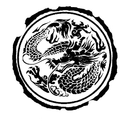Click the blue text above to follow for regular updates!
In the case of Damp-Heat Syndrome (证): symptoms include thirst, yellow tongue coating with prickles, wiry and slow pulse, retracted and stiff tongue, delirium, unawareness of surroundings, and spasms in both hands, indicating dryness of fluids and stagnation of pathogens. Recommended herbs include fresh Sheng Di (Rehmannia), Lu Gen (Reed Rhizome), Sheng Shou Wu (Fresh Fo-Ti), and fresh Dao Gen (Rice Root). If the pulse is strong and there is constipation, Da Huang (Rhubarb) may also be added.
Self-Note: The stomach’s fluids are depleted, and the heat pathogen is entrenched internally. Without moistening and purging to expel the pathogen, it cannot be resolved. Therefore, following the example of the Cheng Qi (Purge the Qi) method, it is advisable to use sweet and cool herbs instead of bitter and cold ones, as there is concern that the stomach Qi may be harmed and the stomach fluids may not recover.
Qing Long’s Summary: From the self-note, it can be seen that this syndrome has both Yin deficiency and heat pathogen in equal measure, along with moving wind that obstructs the orifices, leading to a retracted and stiff tongue, indicating the pathogen has entered the Jue Yin (Liver and Pericardium). The later mention of constipation and the addition of Da Huang indicates that without Da Huang, it is difficult to relieve the heat accumulation!
Using simple Yin-nourishing and heat-clearing herbs may be difficult to treat; it is advisable to refer to Wu Ju Tong’s (Wu Jutong) Wen Bing Tiao Bian (Treatise on Warm Diseases) for the Zeng Ye Cheng Qi Tang (Increase Fluids and Purge Qi Decoction), Hu Wei Cheng Qi Tang (Protect the Stomach and Purge Qi Decoction), and add An Gong Niu Huang (Calm the Palace with Cattle Gallstone) to open the orifices, along with Ling Yang Jiao (Antelope Horn), Gou Teng (Uncaria), and Bai Shao (White Peony) to extinguish wind and stop spasms for a more stable approach!
Related Articles
Xue Shengbai’s “Damp-Heat Syndrome” –Pathogenic Heat Deeply Infiltrating the Heart and Liver Syndrome
Xue Shengbai’s “Damp-Heat Syndrome” – Damp-Heat Affecting the Ying and Xue – Liver and Kidney Yin Deficiency with Moving Wind Syndrome
Xue Shengbai’s “Damp-Heat Syndrome” – Damp-Heat Affecting the Ying and Xue – Qi and Blood Both Burning Syndrome
Xue Shengbai’s “Damp-Heat Syndrome” – Damp-Heat Affecting the Ying and Xue; Pathogen Entering the Jue Yin with Shen Confusion Syndrome

